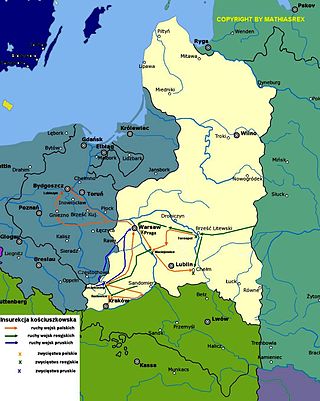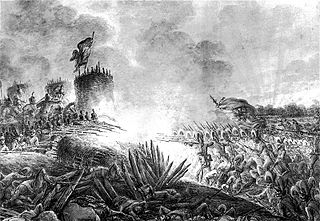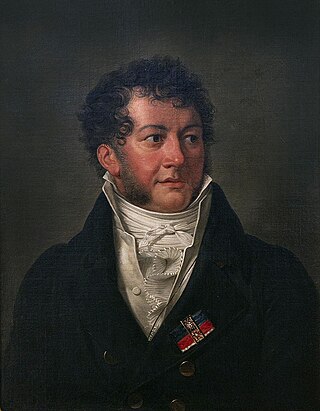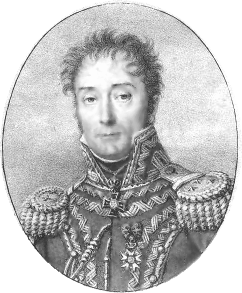
1794 (MDCCXCIV) was a common year starting on Wednesday of the Gregorian calendar and a common year starting on Sunday of the Julian calendar, the 1794th year of the Common Era (CE) and Anno Domini (AD) designations, the 794th year of the 2nd millennium, the 94th year of the 18th century, and the 5th year of the 1790s decade. As of the start of 1794, the Gregorian calendar was 11 days ahead of the Julian calendar, which remained in localized use until 1923.

The Kościuszko Uprising, also known as the Polish Uprising of 1794, Second Polish War, Polish Campaign of 1794, and the Polish Revolution of 1794, was an uprising against the Russian and Prussian influence on the Polish–Lithuanian Commonwealth, led by Tadeusz Kościuszko in Poland-Lithuania and the Prussian partition in 1794. It was a failed attempt to liberate the Polish–Lithuanian Commonwealth from external influence after the Second Partition of Poland (1793) and the creation of the Targowica Confederation.

Warsaw Citadel is a 19th-century fortress in Warsaw, Poland. It was built by order of Tsar Nicholas I after the suppression of the 1830 November Uprising in order to bolster imperial Russian control of the city. It served as a prison into the late 1930s, especially the dreaded Tenth Pavilion of the Warsaw Citadel ; the latter has been a museum since 1963.

The Targowica Confederation was a confederation established by Polish and Lithuanian magnates on 27 April 1792, in Saint Petersburg, with the backing of the Russian Empress Catherine II. The confederation opposed the Constitution of 3 May 1791 and fought in the Polish–Russian War of 1792, which led to the Second and Third Partitions of Poland.

The Battle of Praga or the Second Battle of Warsaw of 1794, also known in Russian and German as the storming of Praga and in Polish as the defense of Praga, was a Russian assault on Praga, the easternmost community of Warsaw, during the Kościuszko Uprising in 1794. It was followed by a massacre of the civilian population of Praga.

Roman Sołtyk was a Polish nobleman (szlachcic), political activist and general.

Michał Kleofas Ogiński was a Polish diplomat and politician, Grand Treasurer of Lithuania, and a senator of Tsar Alexander I. He was also a composer of late Classical and early Romantic music.

The Warsaw Uprising of 1794 or Warsaw Insurrection was an armed insurrection by the people of Warsaw early in the Kościuszko Uprising. Supported by the Polish Army, the uprising aimed to throw off control by the Russian Empire of the Polish capital city (Warsaw). It began on 17 April 1794, soon after Tadeusz Kościuszko's victory at the Battle of Racławice.

The Vilnius Uprising of 1794 began on April 22, 1794, during which Polish-Lithuanian force led by Jakub Jasiński fought Russian forces occupying the city during the Kościuszko Uprising. The Russians were expelled from Vilnius, and thanks to Jasiński's skill, no casualties were sustained during the bloodless uprising. Vilnius townspeople also actively participated in the city's defense from the Russians, some even by throwing stones at them.

Jan Kiliński was a Polish soldier and one of the commanders of the Kościuszko Uprising. A shoemaker by trade, he commanded the Warsaw Uprising of 1794 against the Russian garrison stationed in Warsaw. He also became a member of Polish provisional government.

Count Otto Heinrich Igelström was a Russian general from the noble Swedish family of Igelström. His significant military victory was the siege of the Akkerman fortress in 1770. During the impressive Warsaw Uprising of 1794 Igelström lost control of his eventually defeated forces.

Józef Kazimierz Korwin Kossakowski, of Ślepowron coat of arms, was a Polish noble, bishop of Livonia from 1781, political activist, writer, and supporter of Russian Empire.
Pistorius or Pistor are Latinized surnames, corresponding to the Dutch Bakker or the German Becker and German Müller.

Michał Sokolnicki was a Polish nobleman, general, military engineer, politician, and writer.
Karol Boscamp-Lasopolski was a Dutch diplomat in service of Poland and Russia. He was a Chamberlain in the court of Polish king Stanisław August Poniatowski. He was lynched by a mob during the Warsaw Uprising of 1794.

The siege of Warsaw of 1794 was a joint Russian and Prussian siege of the capital of the Polish–Lithuanian Commonwealth, during the Kościuszko Uprising in the summer of 1794. It ended with the Polish victory when, after a two-month siege, the Prussian and Russian army ended the siege and withdrew from Warsaw.

St. Lawrence's Church is a Roman Catholic church located in Warsaw's borough of Wola. A neoclassicist building, the site is best known as the central point of Polish "Redoubt No. 56" during the 1831 battle for Warsaw.
Jan Jerzy Giessler of Złotorzek was a Polish military officer.
Franciszek Ksawery Niesiołowski was a colonel in the 6th Lithuanian Foot Regiment, general in the Kościuszko Uprising, the Army of the Duchy of Warsaw, and the Army of the Kingdom of Poland, served during the November Uprising, became a member of the Sejm in 1830, and was Senator-Castellan of the Kingdom of Poland from 8 August 1831.














